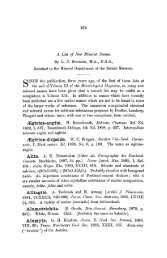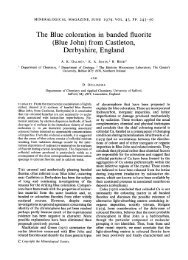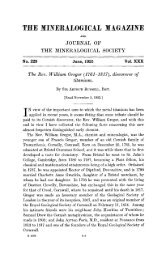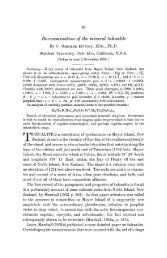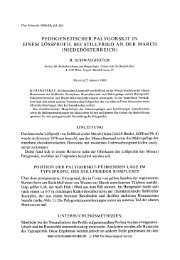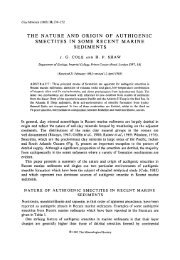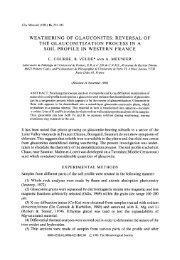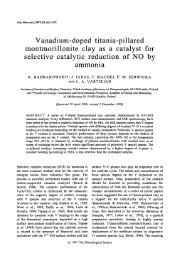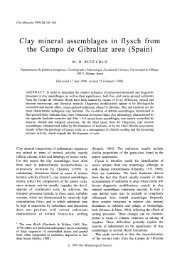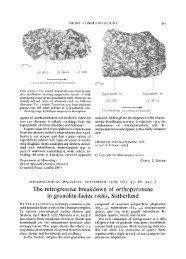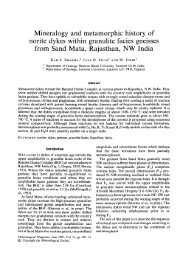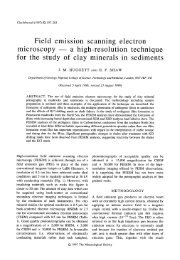Mineral chemistry and reaction textures in metabasites from the ...
Mineral chemistry and reaction textures in metabasites from the ...
Mineral chemistry and reaction textures in metabasites from the ...
Create successful ePaper yourself
Turn your PDF publications into a flip-book with our unique Google optimized e-Paper software.
<strong>M<strong>in</strong>eral</strong> <strong>chemistry</strong> <strong>and</strong> <strong>reaction</strong> <strong>textures</strong> <strong>in</strong><br />
<strong>metabasites</strong> <strong>from</strong> <strong>the</strong> Eastern Ghats belt, India<br />
<strong>and</strong> <strong>the</strong>ir implications<br />
SOMNATH DASGUPTA, PULAK SENGUPTA, A. MONDAL AND M. FUKUOKA*<br />
Department of Geological Sciences, Jadavpur University, Calcutta-700 032, India<br />
Abstract<br />
Three types of mafic granulites, namely two pyroxene-plagioclase granutite (MG), two pyroxene-<br />
plagioclase-garnet granulite (GMG) <strong>and</strong> sp<strong>in</strong>el-oliv<strong>in</strong>e-plagioclase-two pyroxene granulite (SMG)<br />
are exposed at Sunkarimetta, Eastern Ghats belt, India. The marie granulites exhibit a foliation<br />
concordant with that <strong>in</strong> associated granulite facies quartzofeldspathic gneisses. Textural characteristics<br />
<strong>and</strong> m<strong>in</strong>eral chemical data suggest <strong>the</strong> follow<strong>in</strong>g m<strong>in</strong>eral <strong>reaction</strong>s: oliv<strong>in</strong>e + plagioclase = sp<strong>in</strong>el +<br />
orthopyroxene + cl<strong>in</strong>opyroxene (SMG), orthopyroxene + plagioclase = garnet + quartz (GMG),<br />
cl<strong>in</strong>opyroxene + plagioclase = garnet + quartz (GMG) <strong>and</strong> plagioclase + hemoilmenite + quartz =<br />
garnet + ilmenite + 02 (GMG). Geo<strong>the</strong>rmobarometry <strong>in</strong>dicates maximum P-T conditions of<br />
metamorphism at c. 8.5 kbar, 950 ~ The marie granulites later suffered nearly isobaric cool<strong>in</strong>g to c.<br />
7.5 kbar, 750~ Bulk compositional characteristics suggest that SMG is of cumulate orig<strong>in</strong>. The<br />
protoliths of <strong>the</strong> mafic granulites, emplaced at c. 32 km depth, are probably responsible for <strong>the</strong>rmal<br />
perturbation caus<strong>in</strong>g granulite facies metamorphism of <strong>the</strong> enclos<strong>in</strong>g rocks.<br />
KEYWORDS: basite, granulite, texture, Eastern Ghats, India.<br />
Introduction<br />
THE Eastern Ghats granulite belt, occurr<strong>in</strong>g<br />
along <strong>the</strong> eastern coast of India, records an<br />
anticlockwise P-T trajectory of evolution, com-<br />
pris<strong>in</strong>g a prograde path of high T/P, followed<br />
sequentially by nearly isobaric cool<strong>in</strong>g <strong>and</strong> nearly<br />
iso<strong>the</strong>rmal decompression (Kam<strong>in</strong>eni <strong>and</strong> Rao,<br />
1988; Sengupta et al., 1990). It has been argued<br />
that granulite production on an anticlockwise<br />
path is a consequence of magmatic accretion at<br />
<strong>the</strong> base <strong>and</strong>/or with<strong>in</strong> <strong>the</strong> crust (Bohlen, 1987;<br />
Harley, 1989). Marie granulites, occurr<strong>in</strong>g abund-<br />
antly as conformable lenses <strong>in</strong> paragneisses <strong>in</strong> <strong>the</strong><br />
Eastern Ghats, record maximum P-T condition<br />
of metamorphism of 8.5 kbar, 950 ~ (Sengupta<br />
et al., 1990; Dasgupta et al., 1991). In a previous<br />
paper (Dasgupta et al., 1991), we have reasoned<br />
that <strong>the</strong> marie granulites represent <strong>in</strong>traplate<br />
magmatism <strong>and</strong> could be <strong>the</strong> potential energy<br />
source for <strong>the</strong> granulite facies metamorphism <strong>in</strong><br />
<strong>the</strong> Eastern Ghats. In this paper, we provide<br />
m<strong>in</strong>eral chemical data <strong>and</strong> rection <strong>textures</strong> of<br />
three different types of magmatic rocks <strong>from</strong> <strong>the</strong><br />
* Present address: Department of Earth <strong>and</strong> Plane-<br />
tary Sciences, Kyushu University Fukuoka 812, Japan.<br />
<strong>M<strong>in</strong>eral</strong>ogical Magaz<strong>in</strong>e, March 1993, Vol. 57, pp. 113-120<br />
Copyright <strong>the</strong> <strong>M<strong>in</strong>eral</strong>ogical Society<br />
Eastern Ghats granulite belt which bear <strong>the</strong><br />
impr<strong>in</strong>ts of cool<strong>in</strong>g <strong>from</strong> abnormally high<br />
temperature.<br />
Geologic sett<strong>in</strong>g<br />
The Eastern Ghats granulite belt is character-<br />
ised by <strong>the</strong> presence of several varieties of<br />
paragneisses (khondalite or garnet-quartz-perth-<br />
ite-sillimanite gneiss, calc granulites <strong>and</strong> sapphir-<br />
<strong>in</strong>e-sp<strong>in</strong>el granulites), orthogneisscs (plagio-<br />
clase-cl<strong>in</strong>opyroxene-orthopyroxene-garnet<br />
gneiss), alkal<strong>in</strong>e rocks, anorthosites <strong>and</strong> ortho-<br />
pyroxene-bear<strong>in</strong>g quartzofeldspathic gneisses<br />
(Naqvi <strong>and</strong> Rogers, 1987). Isotopic age determi-<br />
nations <strong>in</strong>dicate at least two major phases of<br />
granutite metamorphism at c. 2600 Ma (Perraju<br />
etal., 1979) <strong>and</strong> c. 1000-900 Ma (Grew <strong>and</strong><br />
Manton, 1986; Aftalion etal., 1988; Paul et al.,<br />
1990). Basic magmatism <strong>in</strong> <strong>the</strong> Eastern Ghats has<br />
been dated at 2800-2600 Ma (Paul et al., 1990).<br />
Deformational signatures <strong>in</strong> <strong>the</strong> marie granulites<br />
<strong>in</strong>dicate that <strong>the</strong>se were emplaced syntectonically<br />
with <strong>the</strong> earlier phase of metamorphism (Das-<br />
gupta et al., 1991).
114<br />
The present study area is around Sunkarimetta,<br />
which is halfway between Araku <strong>and</strong> Anantagiri<br />
(see Fig. 1 <strong>in</strong> Dasgupta et al., 1991). The area is<br />
characterised by l<strong>in</strong>ear patches of orthopyroxene<br />
granulite (orthopyroxene-plagioclase-garnet-<br />
perthite~luartz), khondalite <strong>and</strong> quartzite. Con-<br />
formable lenses of marie granulites are present<br />
throughout <strong>the</strong> area <strong>and</strong> are mostly hosted <strong>in</strong><br />
orthopyroxene granulite. Based on <strong>the</strong> presence<br />
<strong>and</strong> absence of garnet, <strong>the</strong> marie granulites can be<br />
divided <strong>in</strong>to a garnetiferous (GMG) <strong>and</strong> a non-<br />
garnetiferous (MG) type. Field relationships<br />
between Mg <strong>and</strong> GMG is not clear, although it is<br />
evident that GMG has a dist<strong>in</strong>ct doma<strong>in</strong>al occur-<br />
fence with<strong>in</strong> MG. With<strong>in</strong> <strong>the</strong> MG doma<strong>in</strong>s<br />
several irregular blocks (maximum dimension 8<br />
5 m) of an unusual marie rock conta<strong>in</strong><strong>in</strong>g sp<strong>in</strong>el-<br />
plagioclase-oliv<strong>in</strong>e-pyroxene occur (SMG). All<br />
<strong>the</strong> types of marie granulites show a weak foliation<br />
marked by parallel arrangement of prismatic<br />
pyroxenes <strong>and</strong>/or ilmenite. The foliation is con-<br />
formable with <strong>the</strong> regional gneissic foliation <strong>in</strong> <strong>the</strong><br />
associated rocks.<br />
Petrography<br />
S. DASGUPTA ETAL.<br />
SMG is characterised by <strong>the</strong> m<strong>in</strong>eral assembl-<br />
age sp<strong>in</strong>el + plagioclase + cl<strong>in</strong>opyroxene +<br />
orthopyroxene + oliv<strong>in</strong>e _+ mica _+ amphibole.<br />
The pyroxenes occur <strong>in</strong> two modes. Coarse<br />
subhedral gra<strong>in</strong>s of ortho- <strong>and</strong> cl<strong>in</strong>opyroxene<br />
show <strong>in</strong>terlock<strong>in</strong>g texture. Orthopyroxene con-<br />
ta<strong>in</strong>s (100) lamellae <strong>and</strong> blebs of cl<strong>in</strong>opyroxene<br />
<strong>and</strong> vice-versa. In <strong>the</strong> o<strong>the</strong>r mode, cl<strong>in</strong>o- <strong>and</strong><br />
orthopyroxene conta<strong>in</strong> vermicular <strong>in</strong>tergrowths<br />
of green sp<strong>in</strong>el (Fig. 1). In addition sp<strong>in</strong>el locally<br />
FIG. 1. Sp<strong>in</strong>el (white) occurs as symplectitic <strong>in</strong>tergrowth<br />
with cl<strong>in</strong>opyroxene (C) <strong>and</strong> orthopyroxene (O). Note a<br />
coarse tabular gra<strong>in</strong> of sp<strong>in</strong>el. Oliv<strong>in</strong>e (Ol) occurs as<br />
relic gra<strong>in</strong>s <strong>in</strong> <strong>the</strong> <strong>in</strong>tergrowth. Black phase is plagio-<br />
clase. EPMA BEI, length of bar is 0.05 ram.<br />
forms coarser tabular gra<strong>in</strong>s, adjacent to <strong>the</strong><br />
pyroxenes (Fig. 1). Oliv<strong>in</strong>e occurs as rare<br />
subrounded gra<strong>in</strong>s enclosed <strong>in</strong> <strong>the</strong> sp<strong>in</strong>el-pyrox-<br />
ene <strong>in</strong>tergrowths <strong>and</strong> gra<strong>in</strong>s are never <strong>in</strong> contact<br />
with plagioclase (Fig. 1). Plagioclase forms coarse<br />
xenomorphic gra<strong>in</strong>s <strong>in</strong> <strong>the</strong> rock. Both amphibole<br />
<strong>and</strong> biotite occur as patchy gra<strong>in</strong>s replac<strong>in</strong>g <strong>the</strong><br />
pyroxenes.<br />
In both MG <strong>and</strong> GMG, ortho- <strong>and</strong> cl<strong>in</strong>opyrox-<br />
erie occur as coarse subhedral gra<strong>in</strong>s, (100)<br />
lamellae <strong>and</strong> orthopyroxene <strong>in</strong> cl<strong>in</strong>opyroxene <strong>and</strong><br />
vice-versa are common features. In MG, plagio-<br />
clase, pyroxene <strong>and</strong> ilmenite show mutual gra<strong>in</strong><br />
contact. In GMG on <strong>the</strong> o<strong>the</strong>r h<strong>and</strong>, plagioclase is<br />
separated <strong>from</strong> <strong>the</strong> pyroxenes as well as <strong>from</strong><br />
ilmenite by th<strong>in</strong> rims of coronal garnet (with or<br />
without quartz) <strong>and</strong> garnet-ilmenite corona res-<br />
pectively (Figs. 2, 3). Tabular ilmenite gra<strong>in</strong>s <strong>in</strong><br />
GMG separated <strong>from</strong> plagioclase by garnet<br />
corona are compositionally hemoilmenite (see<br />
later) <strong>and</strong> are dist<strong>in</strong>ct <strong>from</strong> nearly pure ilmenite<br />
<strong>in</strong>volved <strong>in</strong> <strong>in</strong>tergrowth with garnet. O<strong>the</strong>r phases<br />
<strong>in</strong> MG <strong>and</strong> GMG are K-feldspar, biotite <strong>and</strong><br />
apatite. Biotite is a late phase <strong>in</strong> <strong>the</strong> rocks,<br />
replac<strong>in</strong>g garnet, pyroxenes <strong>and</strong> K-feldspar.<br />
Chemical characteristics<br />
Three representative bulk chemical compo-<br />
sitions of Mg, GMG <strong>and</strong> SMG, determ<strong>in</strong>ed by<br />
XRF, along with <strong>the</strong> modal <strong>and</strong> normative<br />
compositions, are given <strong>in</strong> Table 1. SMG is<br />
chemically an oliv<strong>in</strong>e gabbro <strong>and</strong> is dist<strong>in</strong>ctly<br />
more magnesian <strong>and</strong> alum<strong>in</strong>ous (reflected <strong>in</strong> <strong>the</strong><br />
normative corundum content) than both MG <strong>and</strong><br />
GMG. MG is aga<strong>in</strong> enriched <strong>in</strong> Mg compared<br />
with GMG. All <strong>the</strong> varieties have, however,<br />
hypers<strong>the</strong>ne <strong>and</strong> oliv<strong>in</strong>e <strong>in</strong> <strong>the</strong> norm (Table 1).<br />
The composition of <strong>the</strong> coexist<strong>in</strong>g phases <strong>in</strong><br />
<strong>the</strong>se rocks were determ<strong>in</strong>ed by JEOL-JXA 733<br />
<strong>and</strong> 8600 EPMA, <strong>and</strong> representative data are<br />
given <strong>in</strong> Tables 24. In SMG, sp<strong>in</strong>el is essentially<br />
hercynite-sp<strong>in</strong>el solid solution with XMg [= Mg/<br />
(Mg + FEZ+)] close to 0.5 (Table 2). Recalculated<br />
Fe203 content <strong>in</strong> sp<strong>in</strong>el varies between 2.69 <strong>and</strong><br />
3.38 wt.%. Oliv<strong>in</strong>e is FO66 Fa34 <strong>and</strong> <strong>the</strong> compo-<br />
sition of plagioclase is close to An70 (Table 2).<br />
Both types of pyroxene are more alum<strong>in</strong>ous than<br />
those <strong>in</strong> MG <strong>and</strong> GMG; A1203 wt.% <strong>in</strong> orthopyr-<br />
oxene varies with<strong>in</strong> <strong>the</strong> range 2.91-3.35 <strong>and</strong> <strong>in</strong><br />
cl<strong>in</strong>opyroxene 4.05-3.03. Lower range values are<br />
recorded when <strong>the</strong>se are <strong>in</strong>tergrown with sp<strong>in</strong>el.<br />
Orthopyroxenes are enstatitic (XMg = 0.71),<br />
while cl<strong>in</strong>opyroxenes are essentially diopside-<br />
hedenbergite solid solutions with XMg = 0.8<br />
(Table 2).<br />
Orthopyroxenes <strong>in</strong> MG have higher XMg (0.58-
METABASITES 115<br />
Fro. 2 (left). Garnet (G) - quartz (Q) symplectite <strong>in</strong> between orthopyroxene (O) <strong>and</strong> plagioclase (P). Length of bar is<br />
0.05 mm. Fro. 3 (right). Garnet (G) - ilmenite (black) symplectite around hemoilmenite (black) <strong>in</strong> presence of<br />
plagioclase (P) <strong>in</strong> GMG. Length of bar is 0.025 ram.<br />
0.61) than those <strong>in</strong> GMG (XMg = 0.37--0.39)<br />
(Table 3). Octahedral alum<strong>in</strong>ium content <strong>in</strong> <strong>the</strong><br />
orthopyroxenes varies <strong>in</strong> <strong>the</strong> range 0.01.0.04.<br />
Chemical composition of coarse subhedral ortho-<br />
pyroxene <strong>and</strong> that occurr<strong>in</strong>g as (100) lamellae <strong>in</strong><br />
cl<strong>in</strong>opyroxene are generally comparable. Cl<strong>in</strong>o-<br />
pyroxenes <strong>in</strong> both MG <strong>and</strong> GMG are essentially<br />
solid solutions of diopside--hedenbergite with<br />
low jadeite (1.7-2.8m01.%), Ca-Tschermak<br />
(max. 3.96 mol.%) <strong>and</strong> TiO2 content (Table 3).<br />
However, <strong>the</strong>se are more magnesian (XMg =<br />
0.71-0.74) <strong>in</strong> MG as compared to <strong>in</strong> GMG (XMg<br />
= 0.56--0.53). Compositions of coexist<strong>in</strong>g cl<strong>in</strong>o-<br />
<strong>and</strong> orthopyroxenes, when plotted <strong>in</strong> <strong>the</strong> pyrox-<br />
ene quadrilateral (Fig. 4), clearly show that XMg<br />
<strong>in</strong>creases <strong>in</strong> <strong>the</strong> order GMG-MG-SMG.<br />
Coarse subhedral ilmenite def<strong>in</strong><strong>in</strong>g <strong>the</strong> weak<br />
foliation <strong>in</strong> MG <strong>and</strong> GMG are hemoilmenite with<br />
3-4 wt.% Fe203 (calculated after Bohten <strong>and</strong><br />
Essene, 1977) (Table 4). On <strong>the</strong> o<strong>the</strong>r h<strong>and</strong>,<br />
ilmenite <strong>in</strong>tergrown with coronal garnet <strong>in</strong> GMG<br />
is nearly pure FeTiO3 (Table 4). Plagioclase <strong>in</strong><br />
GMG shows sharp zon<strong>in</strong>g, with higher albite<br />
towards <strong>the</strong> rim (XAb <strong>in</strong> <strong>the</strong> core is 0.29 <strong>and</strong> <strong>in</strong> <strong>the</strong><br />
rim adjacent to coronal garnet is 0.47; Table 4).<br />
Zon<strong>in</strong>g is less conspicuous <strong>in</strong> plagioclase of MG,<br />
never<strong>the</strong>less <strong>the</strong> same trend is noted (X~A~ e =<br />
0.28, .'lAb vRim = 0.38). The composition of coronal<br />
garnet <strong>in</strong> GMG is nearly homogeneous<br />
(AIm6sGr20PY13Sp2) irrespective of <strong>the</strong> nature of<br />
<strong>the</strong> phase (platioclase, orthopyroxene, ilmenite<br />
or cl<strong>in</strong>opyroxene) it rims (Table 4).<br />
<strong>M<strong>in</strong>eral</strong> <strong>reaction</strong>s<br />
In SMG relatively alum<strong>in</strong>ous r<br />
conta<strong>in</strong> (100)exsolution lamellae of orthopyrox-<br />
TABLE 1. Bulk chemical compositions, modal <strong>and</strong> normative compositions of MG, GMG <strong>and</strong> SMG<br />
Bulk Composition Modal Analysis CIPW Norm<br />
SMG MG GMG SMG MG GMG SMG MG GMG<br />
SiO2 46.03 48.80 47.92 Opx 28 25 20 T1 2.73 4.70 7.48<br />
A1203 21.93 7.63 6.64 cpx 25 18 15 Ap 0.03 .03 .03<br />
TiO2 1.43 2.48 3.94 ol 2 -- -- Kf 3.03 8.90 8.68<br />
FeO 7.29 13.62 16.78 sp 6 -- -- Ab 7.76 9.17 10.28<br />
MnO 0.06 0.05 0.04 PI 40 35 38 An 46.23 11.48 8.32<br />
CaO 9.34 9.81 11.14 Am 8 -- -- Co 2.85 -- --<br />
MgO 11.06 14.34 9.39 Bi 1 2 1 Di -- 19.92 20.33<br />
K20 0.63 1.51 1.47 gt -- -- 7 Hd -- 10.22 18.48<br />
Na20 0.92 1.09 1.22 I1 -- 2 5 Fo 5.32 11.62 5.33<br />
P205 0.02 0.028 0.027 Kf -- 10 8 FI 2.36 7.53 4.60<br />
(H20) 0.18 -- -- Qtz - 7 5 En 19.92 9.87 7.30<br />
Total 98.90 99.35 98.54 Ap --
116 S. DASGUPTA ET AL.<br />
TABLE 2. Composition of sp<strong>in</strong>el, orthopyroxene, cl<strong>in</strong>opyroxene, oliv<strong>in</strong>e <strong>and</strong> plagioclase <strong>in</strong> SMG<br />
No. 1 2 3 4 5 6 7 8<br />
SiO 2 0.01 0.05 36.88 50.54 52.32 52.48 52.43 51.87<br />
TiO2 0.06 0.01 -- -- 0.07 0.03 0.05 0.06<br />
A1203 62.37 61.81 -- 31.09 2.91 3.35 3.03 4.05<br />
Fe203 2.69 3.38 -- 0.06 . . . .<br />
FeO 22.57 22.18 30.94 -- 18.17 17.31 6.66 6.50<br />
MnO 0.13 0.15 0.32 -- 0.46 0.36 0.22 0.17<br />
MgO 12.52 12.63 32.97 -- 24.98 25,41 15.03 14.65<br />
CaO 0.04 0.05 -- 14.28 0.42 0.54 22.53 22.14<br />
Na20 0.01 -- -- 3.29 . . . .<br />
K20 -- -- -- 0.10 . . . .<br />
Total 100.30 100.26 101.11 99.36 99.33 99.48 99.95 99.44<br />
Oxygen<br />
Basis 4 4 4 8 6 6 6 6<br />
Si -- -- 0.99 2.31 1.92 1.92 1.93 1.91<br />
Ti . . . . . . . .<br />
AI 1.94 1.93 -- 1.68 0.13 0.15 0.13 0.18<br />
Fe 3+ 0.05 0.07 . . . . . .<br />
Fe 2+ 0.50 0.49 0.69 -- 0.56 0,53 0.20 0.20<br />
Mn -- -- 0.01 -- 0.01 0.01 -- --<br />
Mg 0.49 0.50 1.32 -- 1.37 1,38 0.82 0.80<br />
Ca -- -- -- 0.70 0.01 0.02 0.89 0.88<br />
Na -- -- -- 0.29 . . . .<br />
K -- -- -- 0,01 . . . .<br />
1,2 Sp<strong>in</strong>el; 3, Oliv<strong>in</strong>e; 4, Plagioclase; 5, Orthopyroxene with <strong>in</strong>tergrown sp<strong>in</strong>el; 6, Primary orthopyroxene; 7,<br />
Cl<strong>in</strong>opyroxene with <strong>in</strong>tergrown sp<strong>in</strong>el; 8, Primary cl<strong>in</strong>opyroxene.<br />
ene. Similarly, alum<strong>in</strong>ous orthopyroxene con-<br />
ta<strong>in</strong>s lamellae of cl<strong>in</strong>opyroxene. Re<strong>in</strong>tegration of<br />
<strong>the</strong> pyroxene compositions follow<strong>in</strong>g <strong>the</strong> method<br />
of S<strong>and</strong>iford <strong>and</strong> Powell (1986) show that prior to<br />
exsolution, subcalcic augite <strong>and</strong> pigeonite were<br />
present <strong>in</strong> <strong>the</strong> rock. Textural features <strong>in</strong>dicate<br />
that <strong>the</strong>se, toge<strong>the</strong>r with oliv<strong>in</strong>e <strong>and</strong> plagioclase,<br />
constitute <strong>the</strong> primary assemblage <strong>in</strong> <strong>the</strong> SMG.<br />
Textural relations (Fig. 1) <strong>and</strong> <strong>the</strong> compositional<br />
plots <strong>in</strong> <strong>the</strong> CA (FM) system (Fig. 5) (suggest that<br />
<strong>the</strong> sp<strong>in</strong>el - OPX - CPX <strong>in</strong>tergrowth orig<strong>in</strong>ated<br />
via <strong>the</strong> m<strong>in</strong>eral <strong>reaction</strong>,<br />
Oliv<strong>in</strong>e + plagioclase = cl<strong>in</strong>opyroxene +<br />
orthopyroxene + sp<strong>in</strong>el. (1)<br />
Re<strong>in</strong>tegration of pyroxene compositions <strong>in</strong> MG<br />
<strong>and</strong> GMG also show that subcalcic augite <strong>and</strong><br />
pigeonite existed prior to exsolution. It is evident<br />
<strong>from</strong> <strong>the</strong> textural relations that <strong>the</strong>se, toge<strong>the</strong>r<br />
with hemoilmenite <strong>and</strong> plagioclase, constituted<br />
<strong>the</strong> primary assemblage <strong>in</strong> both <strong>the</strong>se rocks.<br />
Coronal garnet subsequently appeared <strong>in</strong> iron-<br />
rich GMG through several <strong>reaction</strong>s. Develop-<br />
ment of coronal garnet-quartz symplectite<br />
around ortho- <strong>and</strong> cl<strong>in</strong>opyroxene <strong>and</strong> plagioclase<br />
can be attributed to <strong>the</strong> <strong>reaction</strong>s,<br />
Orthopyroxene + plagioclase = garnet + quartz,<br />
(2)<br />
Cl<strong>in</strong>opyroxene + plagioclase = garnet + quartz.<br />
(3)<br />
On <strong>the</strong> o<strong>the</strong>r h<strong>and</strong>, formation of garnet-ilmenite<br />
symplectite around plagioclase <strong>and</strong> hemoilmenite<br />
is due to <strong>the</strong> deoxidation equilibria,<br />
Plagioclase + hemoilmenite + quartz = garnet +<br />
ilmenite + O2 (4)<br />
Compositional homogeniety of garnets rimm<strong>in</strong>g<br />
orthopyroxene, cl<strong>in</strong>opyroxene, plagioclase <strong>and</strong><br />
ilmenite suggests that <strong>the</strong> <strong>reaction</strong>s (2), (3) <strong>and</strong><br />
(4) occurred simultaneously.<br />
All <strong>the</strong> rocks suffered late hydration which<br />
resulted <strong>in</strong> <strong>the</strong> appearance of amphibole <strong>and</strong><br />
biotite. It may be recalled here that late hydration<br />
<strong>and</strong> K-metasomatism are <strong>the</strong> features common to<br />
o<strong>the</strong>r Eastern Ghats rocks (Sengupta et al., 1990;<br />
Dasgupta et al., 1991).<br />
Geo<strong>the</strong>rmobarometry<br />
Compositions of coexist<strong>in</strong>g primary ortho- <strong>and</strong><br />
cl<strong>in</strong>opyroxenes <strong>in</strong> <strong>the</strong> SMG give a temperature of<br />
940 ~ follow<strong>in</strong>g Kretz (1982), while <strong>the</strong> pyroxene<br />
<strong>in</strong>tergrown with sp<strong>in</strong>el record temperatures <strong>in</strong> <strong>the</strong><br />
range 800-830~ There is no well calibrated<br />
barometer appropriate for <strong>the</strong> SMG. The empiri-
METABASITES<br />
TABLE 3. Composition of orthopyroxene, cl<strong>in</strong>opyroxene <strong>in</strong> MG <strong>and</strong> GMG<br />
No. 1 2 3 4 5 6 7 8<br />
SiO2 52.68 51.20 50.09 50.17 52.26 51.62 51.45 51.19<br />
Ti02 0.16 0.10 0.13 0.07 0.28 0.35 0.14 0.17<br />
A1203 1.07 2.52 1.05 0.43 1.50 2.62 1.25 1.26<br />
FeO 23.53 25.25 35.74 35.44 8.52 9.24 15.05 14.96<br />
MnO 0.68 0.64 0.42 0.60 0.25 0.17 0.26 0.14<br />
MgO 21.42 19.82 11.92 13.24 13.79 12.84 9.73 10.53<br />
CaO 0.64 0.64 0.83 0.58 22.08 21.84 21.56 21.36<br />
Na20 . . . . 0.22 0.35 0.26 0.28<br />
Total 100.18 100.17 100.18 100.53 98.90 99.03 99.70 99.89<br />
Oxygen<br />
Basis 6 6 6 6 6 6 6 6<br />
Si 1.971 1.933 1.987 1.983 1.967 1.946 1.978 1.964<br />
Ti 0.005 0.003 0.004 0.002 0.008 0.010 0.004 0.005<br />
AI iv 0.029 0.067 0.013 0.017 0.033 0.054 0.022 0.036<br />
AI vi 0.018 0.045 0.036 0.003 0.034 0.062 0.035 0.021<br />
Fe 2+ 0.736 0.797 1.186 1.171 0.268 0.291 0.484 0.480<br />
Mn 2+ 0.022 0.020 0.014 0.020 0.008 0.005 0.008 0.005<br />
Mg 1.194 1.116 0.705 0.780 0.774 0.721 0.558 0.602<br />
Ca 0.026 0.026 0.035 0.025 0.891 0.882 0.888 0.878<br />
Na20 . . . . 0.016 0.026 0.019 0.021<br />
Xmg 0.618 0.583 0.372 0.399 0.742 0,712 0.535 0.556<br />
Xw 0.381 0.416 0.627 0.600 0.257 0.287 0.464 0.443<br />
CaTs tool% 1.98 3.96 1.76 --<br />
Jd mo]% 1.76 2.86 2.09 2.33<br />
1, Orthopyroxcne porphyroblast of MG; 2, Orthopyroxene exsolved <strong>in</strong> cl<strong>in</strong>opyroxene of MG; 3, Exsolved<br />
orthopyroxene <strong>in</strong> cl<strong>in</strong>opyroxene of GMG; 4, Orthopyroxene porphyroblast of GMG; 5, 6, Porphyroblastic<br />
cl<strong>in</strong>opyroxene of MG; 7, Porphyroblastic cl<strong>in</strong>opyroxene of GMG; 8, Cl<strong>in</strong>opyroxene exsolved <strong>in</strong> orthopyroxene<br />
porphyroblast of GMG.<br />
0%<br />
Ca<br />
0 II ~ ~ \\<br />
"\ 0.3<br />
ii ~ ~ + SMG<br />
I I I ~<br />
~I ~ ~ eMG<br />
~ ~ o GMG<br />
II l \ \\<br />
I I<br />
v v ,,~'+ Mitt V V<br />
Mg 0.1 0.3 0.5 0.7 0.9 Fe<br />
Fro. 4, Plots of Orthopyroxenc <strong>and</strong> cl<strong>in</strong>opyroxenr <strong>in</strong> SMG, MG <strong>and</strong> GMG <strong>in</strong> pyroxene quadrilateral.<br />
117
118 S. DASGUPTA ETAL.<br />
TABLE 4. Composition of ilmenite, plagioclase (MG <strong>and</strong> GMG) <strong>and</strong> Garnet (GMG)<br />
No. 1 2 3 4 5 6 7<br />
Core Rim Core Rim<br />
SiO 2 50.89 55.84 50.70 54.05 38.27 38.41<br />
TiO2 . . . . 0.03 0.05<br />
A1203 30.47 27.67 30.85 29.10 21.17 21.37<br />
Fe203 0.24 0.32 0.50 0.18 0.20 --<br />
FeO . . . . 29.09 29.61<br />
MnO -- -- -- 1.06 1.13<br />
MgO . . . . 3.29 2.70<br />
CaO 13.72 10.19 13.68 12.02 7.23 7.27<br />
ZnO . . . . 0.20 0.04<br />
Na20 3.15 5.15 3.07 4.25 -- --<br />
K20 0.12 0.20 0.22 0.25 -- --<br />
Total 98.59 99.37 99.02 99.85 100.54 100.58<br />
Oxygen<br />
basis 8 8 8 8 12 12<br />
Si 2.243 2.523 2.326 2.443 3.015 3.027<br />
Ti . . . . 0.002 0.003<br />
A1 1.653 1.474 1.668 1.550 1.966 1.985<br />
Fe 3+ 0.008 0.011 0.017 0.006 0.012 --<br />
Fe 2+ . . . . 1.917 1.951<br />
Mn . . . . 0.071 0.075<br />
Mg . . . . 0.386 0.317<br />
Ca 0.677 0.493 0.672 0.582 0.610 0.614<br />
Zn . . . . 0.012 --<br />
Na 0.281 0.451 0.273 0.373 -- --<br />
K 0.007 0.012 0.013 0.014 -- --<br />
Xan 0.701 0.515 0.701 0.600<br />
Nab 0.291 0.471 0.284 0.384<br />
XaJm 0.642 0.659<br />
Xspes s 0.023 0.025<br />
Xpy r 0.129 0.107<br />
Xgros 0.204 0.207<br />
XFe203<br />
XFeTiO3<br />
51.26 51.03 51.96<br />
3.73 2.98 1.20<br />
43.76 44.75 46.10<br />
0.62 0.36 0.22<br />
0.82 0.44 0.24<br />
100.19 99.56 99.72<br />
12 12 12<br />
3.849 3.882 3.951<br />
0.280 0.227 0.092<br />
3.653 3.786 3.897<br />
0.052 0.031 0.019<br />
0.112 0.066 0.036<br />
0.068 0.055 0.022<br />
0.891 0.921 0.963<br />
1, Plagioclase <strong>in</strong> GMG; 2, Plagioclase <strong>in</strong> MG; 3, Coronal garnet <strong>in</strong> between plagioclase <strong>and</strong> ilmenite; 4, Coronal<br />
garnet <strong>in</strong> between plagioclase <strong>and</strong> ortbopyroxene; 5, Ilmenite <strong>in</strong> MG; 6, Ilmenite <strong>in</strong> GMG; 7, Ilmenite <strong>in</strong>tergrown<br />
with coronal garnet <strong>in</strong> GMG.<br />
cally formulated anorthite-Ca-Tschermak-<br />
quartz barometer (Wood, 1977; Ellis, 1980) gives<br />
'maximum' pressure of 9.5 kbar at <strong>the</strong> recorded<br />
Tmax of 940 ~ Comparison of ~C~]T,--Xea~I with<br />
those <strong>in</strong> o<strong>the</strong>r granulite terranes (cf. Martignole,<br />
1979) <strong>in</strong>dicates pressures <strong>in</strong> <strong>the</strong> range 8-8.5 kbar.<br />
Early stabilisation of oliv<strong>in</strong>e-plagioclase-cpx-<br />
opx assemblage <strong>in</strong> <strong>the</strong> SMG <strong>and</strong> late appearance<br />
of sp<strong>in</strong>el set an upper pressure limit of 8.5 kbar<br />
accord<strong>in</strong>g to <strong>the</strong> data of Herzberg (1978) <strong>in</strong> <strong>the</strong><br />
system CaO-MgO-Al203-SiO2. The presence of<br />
iron <strong>in</strong> <strong>the</strong> system will fur<strong>the</strong>r lower this pressure<br />
maxima. Similar estimates are obta<strong>in</strong>ed <strong>from</strong> <strong>the</strong><br />
experimental data of Kushiro <strong>and</strong> Yoder (1966)<br />
<strong>and</strong> Emslie (1970) on <strong>reaction</strong> (1).<br />
The compositions of coexist<strong>in</strong>g pyroxenes<br />
devoid of exsolution lamellae <strong>in</strong> MG give a<br />
maximum temperature of 850~ (after Kretz,<br />
1982), while <strong>the</strong> host-lamellae compositions <strong>in</strong> <strong>the</strong><br />
same rock record Tma of 780 ~ Simultaneous<br />
solution of garnet-orthopyroxene <strong>the</strong>rmometer<br />
(Lee <strong>and</strong> Ganguly, 1988) <strong>and</strong> GOPS barometer<br />
(Perk<strong>in</strong>s <strong>and</strong> Chippera, 1985), as well as GCPS<br />
barometer (Moecher et al., 1988) <strong>and</strong> garnet-<br />
cl<strong>in</strong>opyroxene <strong>the</strong>rmometer (Ellis <strong>and</strong> Green,<br />
1979) <strong>in</strong> <strong>the</strong> GMG give concordant results of<br />
7.5 kbar, 760 ~ These P-T values can be taken<br />
to represent <strong>the</strong> condition of formation of coronal<br />
garnet <strong>in</strong> <strong>the</strong> GMG.<br />
In summary, <strong>the</strong> studied rocks record Tmax. of<br />
metamorphism c. 950~ which is strik<strong>in</strong>gly<br />
similar to <strong>the</strong> recorded temperature maxima <strong>in</strong>
3 0 / " ~ ~<br />
METABAS1TES 119<br />
l -- = : . . . . . . . . -'- "~' 01<br />
,50 40 30 20 10 opx<br />
(AI203+ Fe203) (FeOeMgO)<br />
FIG. 5. Compositional plots of <strong>the</strong> phases <strong>in</strong> C (CaO) A (A1203 + Fe203) FM (FeO + MgO) space <strong>in</strong> SMG.<br />
adjacent areas of <strong>the</strong> Eastern Ghats (Sengupta<br />
etal., 1990; Dasgupta etal., 1991), Pressure<br />
dur<strong>in</strong>g <strong>the</strong> Tmax. cannot be calculated. However,<br />
it did not exceed 8.5 kbar as argued earlier. This is<br />
also consistent with <strong>the</strong> recorded Pmax. <strong>in</strong> <strong>the</strong><br />
Eastern Ghats (Sengupta et al., 1990). A T~ax.-<br />
Pma of 950~ <strong>and</strong> 8.5 kbar of metamorphism<br />
would imply that <strong>the</strong> complex subsequently<br />
suffered a nearly isobaric cool<strong>in</strong>g to 750~<br />
7.5 kbar when coronal garnet appeared <strong>in</strong> <strong>the</strong><br />
GMG. The formation of sp<strong>in</strong>el-opx-cpx <strong>in</strong>ter-<br />
growth via <strong>reaction</strong> (1) is usually attributed to<br />
cool<strong>in</strong>g <strong>from</strong> igneous temepratures (Griff<strong>in</strong> <strong>and</strong><br />
O'Reilley, 1987). Such <strong>textures</strong> have earlier been<br />
reported <strong>from</strong> lower crustal rocks (McBirney <strong>and</strong><br />
Aoki, 1973; Francis, 1976). <strong>in</strong> <strong>the</strong> present situa-<br />
tion, however, <strong>reaction</strong> (1) could additionally<br />
occur <strong>in</strong> response to cool<strong>in</strong>g <strong>from</strong> peak metamor-<br />
phic temperatures.<br />
Discussion<br />
The extremely high MgO <strong>and</strong> A1203 contents<br />
<strong>and</strong> <strong>in</strong>significant K20 content of <strong>the</strong> SMG are<br />
<strong>in</strong>dicative of its cumulate orig<strong>in</strong> (cf. Griff<strong>in</strong> <strong>and</strong><br />
O'Reilley, 1987). Identical P-T history of SMG<br />
<strong>and</strong> <strong>the</strong> associated rocks corroborates with <strong>the</strong><br />
contention that SMG does not represent xenoliths<br />
carried up <strong>from</strong> greater depths by <strong>the</strong> magma.<br />
The primary m<strong>in</strong>eral assemblage of oliv<strong>in</strong>e-<br />
plagioclase-opx-cpx <strong>in</strong> <strong>the</strong> SMG constra<strong>in</strong> <strong>the</strong><br />
emplacement of <strong>the</strong> magma occurred to a depth c.<br />
32 k<strong>in</strong>, correspond<strong>in</strong>g to a pressure of 8.5 kbar.<br />
Cool<strong>in</strong>g fo <strong>the</strong> magmatic complex at depth may<br />
have provided <strong>the</strong> heat source for <strong>the</strong>rmal pertur-<br />
CaO<br />
bation caus<strong>in</strong>g granulite facies metamorphism of<br />
<strong>the</strong> enclos<strong>in</strong>g rocks (cf. Frost <strong>and</strong> Frost, 1987).<br />
Formation of sp<strong>in</strong>el <strong>in</strong> SMG took place dur<strong>in</strong>g<br />
cool<strong>in</strong>g ei<strong>the</strong>r <strong>from</strong> igneous temperatures or <strong>from</strong><br />
peak metamorphic temperatures. Exsolution <strong>in</strong><br />
pyroxenes <strong>and</strong> formation of garnet are <strong>the</strong><br />
consequences of isobaric cool<strong>in</strong>g of <strong>the</strong> complex<br />
subsequent to peak metamorphic conditions.<br />
Non-appearance of garnet <strong>in</strong> <strong>the</strong> SMG <strong>and</strong> MG is<br />
due to <strong>the</strong>ir relatively magnesian bulk compo-<br />
sition at <strong>the</strong> ambient P-T conditions of metamor-<br />
phism (cf. Green <strong>and</strong> R<strong>in</strong>gwood, 1967).<br />
Acknowledgement<br />
S. D. acknowledges <strong>the</strong> University Grants Commission<br />
<strong>and</strong> P. S. <strong>and</strong> A. M. acknowledge <strong>the</strong> Council of<br />
Scientific <strong>and</strong> Industrial Research for f<strong>in</strong>ancial assist-<br />
ance. Discussion with P. K. Bhattacharya was helpful.<br />
We thank Dr. R. C. Newton <strong>and</strong> two anonymous<br />
reviewers for helpful suggestions on an earlier draft of<br />
<strong>the</strong> manuscript.<br />
References<br />
Aftalion, M, Bowes, D. R., Dash, B., <strong>and</strong> Dempster,<br />
T. J. (1988) J. Geol., 96, 663-72.<br />
Bohlen, S. R. (1987) Ibid., 95,239~o2.<br />
<strong>and</strong> Essene, E. J. (1977) Contrib. <strong>M<strong>in</strong>eral</strong>. Petrol.,<br />
62, 153~9.<br />
Dasgupta, S., Sengupta, P., Fukuoka, M., <strong>and</strong> Bhatta-<br />
charya, P. K. (1991) J. Geol., 99, 124-33.<br />
Ellis, D. J. (1980) Contrib. <strong>M<strong>in</strong>eral</strong>. Petrol., 74, 21-1.<br />
-- <strong>and</strong> Green, D. H. (1979) Ibid., 71, 13-21.<br />
Emslie, R. F. (1970) Carnegie Inst. Yearbook, 69,<br />
154-5.<br />
Francis, D. M. (1976) Can. <strong>M<strong>in</strong>eral</strong>., 14,291-8.
120<br />
Frost, D. R. <strong>and</strong> Frost, C. D. (1987) Nature, 327,503--6.<br />
Green, D. H. <strong>and</strong> R<strong>in</strong>gwood, A. E. (1967) Geochim.<br />
Cosmochim. Acta, 37,767-833.<br />
Grew, E. S. <strong>and</strong> Manton, W. I. (1986) Precamb. Res.,<br />
33, 123-39.<br />
Griff<strong>in</strong>, W. L. <strong>and</strong> O'Reilly, S. Y. (1987) In Mantle<br />
Xenoliths (Nixon, P., ed.), Spr<strong>in</strong>ger, New York.<br />
267-80.<br />
Harley, S. L. (1989) Geol. Mag., 126, 215-47.<br />
Herzberg, C. T. (1978) Geochim. Cosmochim. Acta,<br />
42, 945-57.<br />
Kam<strong>in</strong>eni, D. C. <strong>and</strong> Rao, A. T. (1988) Am. <strong>M<strong>in</strong>eral</strong>.,<br />
73, 692-700.<br />
Kretz, R. (1982) Geochirn. Cosmoehim. Acta, 46,<br />
411-21.<br />
Kushiro, I. <strong>and</strong> Yoder, M_ S. (1966) J. Petrol., 7,<br />
337-52.<br />
Lee, H. Y. <strong>and</strong> Ganguly, J. (1988) Ibid., 29, 93-113.<br />
Martignole, J. (1979) Precamb. Res., 9, 303-10.<br />
McBirney, R. A. <strong>and</strong> Aoki, K. (1973) Am. <strong>M<strong>in</strong>eral</strong>.,<br />
58, 271-6.<br />
S. DASGUPTA ETAL.<br />
Moecher, D. P., Essene, E. J., <strong>and</strong> Anovitz, L. (1988)<br />
Contrib. <strong>M<strong>in</strong>eral</strong>. Petrol, 100, 92-106.<br />
Naqvi, S. N. <strong>and</strong> Rogers, J. J. W. (1987) Precambrian<br />
Geology of India. Oxford University Press, 283 pp.<br />
Paul, D. K., Ray Barman, T. K., Mcnaughton, N. J.,<br />
Fletcher, I. R., Potts, P. J., Ramkrishnan, M., <strong>and</strong><br />
August<strong>in</strong>e, P. F. (1990) J. Geol., 98,253-63.<br />
Perk<strong>in</strong>s, D. <strong>and</strong> Chippera, S. J. (1985) Contrib.<br />
<strong>M<strong>in</strong>eral</strong>. Petrol., 89, 69-80.<br />
Perraju, P., Kovach, A., <strong>and</strong> Sv<strong>in</strong>gor, E. (1979)<br />
J. Geol. Soc. Ind., 20, 290~.<br />
S<strong>and</strong>iford, M. K. <strong>and</strong> Powell, R. (1986) Am. <strong>M<strong>in</strong>eral</strong>.,<br />
71,946-54.<br />
Sengupta, P., Dasgupta, S., Bhattacharya, P. K.,<br />
Fukuoka, M., Chakraborti, S., <strong>and</strong> Bhowmick, S.<br />
(1990) J. Petrol., 31,971-96.<br />
Wood, B. J. (1977) Philos. Trans. R. Soc. Lond., 286,<br />
331-42.<br />
[Manuscript received 2 April 1991:<br />
revised 5 March 1992]



